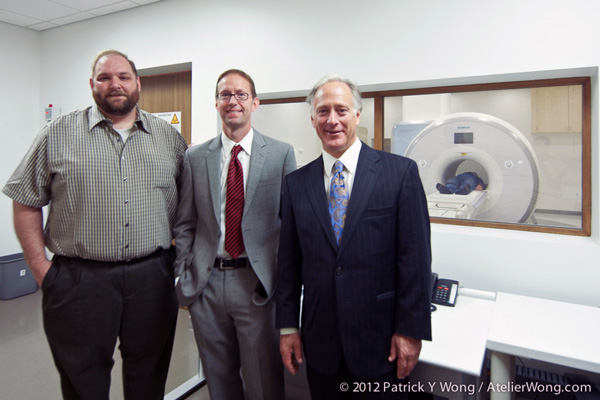Facility includes a state-of-the-art magnetic resonance imaging (MRI) scanner that is dedicated to research and promises to accelerate the translation of basic research to the clinic.
 Jeff Luci, research assistant professor of neurobiology, Russ Poldrack, neurobiology professor and director of the Imaging Research Center, and Sen. Kirk Watson at the grand-opening ceremony for the IRC on May 10, 2012.AUSTIN, Texas — The University of Texas at Austin’s Imaging Research Center (IRC) opened last week, ushering in a new set of research capacities for neuroscience and cancer research at the university.
Jeff Luci, research assistant professor of neurobiology, Russ Poldrack, neurobiology professor and director of the Imaging Research Center, and Sen. Kirk Watson at the grand-opening ceremony for the IRC on May 10, 2012.AUSTIN, Texas — The University of Texas at Austin’s Imaging Research Center (IRC) opened last week, ushering in a new set of research capacities for neuroscience and cancer research at the university.
The facility includes a state-of-the-art magnetic resonance imaging (MRI) scanner that is dedicated to research and promises to accelerate the translation of basic research to the clinic.
“We see the Imaging Research Center playing a role as a hub for translational research,” said Russ Poldrack, professor of neurobiology and psychology and director of the center. “The IRC will link pre-clinical research with human research and provide the bench-to-bedside transition needed for neuroscience research in Austin.”
The new facility is located on the main campus in the Norman Hackerman Building, which houses faculty members in biological sciences and chemistry studying neurological disease, learning and memory, drugs and diagnostics.
Research at the IRC includes investigations of brain functions associated with learning and memory, investigating the underlying factors associated with post-traumatic stress disorder (PTSD), understanding brain functions as they relate to addiction, and other biological processes appropriate for study using MRI, such as cancer.
The facility includes an MRI scanner customized for functional magnetic resonance imaging (fMRI) research and several other imaging technologies. One of the technologies has resolution high enough to image brains as small as those found in fruit flies. Poldrack says that particular tool will be very important for cancer research.
“The motto, 'What starts here changes the world,' is embodied in this sort of facility and research,” said state Sen. Kirk Watson at the grand-opening ceremony on Thursday, May 10. “This is an important investment for our community's health as well as our region's economy.”
Watson has been leading efforts to establish Central Texas as a center for advanced health care through his “10 in 10” initiative, which includes a vision for establishing a medical school linked with The University of Texas at Austin. The University of Texas System Regents recently approved the allocation of up to $30 million a year from the state's Available University Fund to establish a medical school.
“Fulfilling these goals will make Austin a center for medical excellence and have a transformative effect on the region, its economy and its quality of life,” Watson said. "We'll achieve these goals thanks to these kinds of assets and investments."
The Imaging Research Center was made possible in part from $3.8 million in funds provided through the American Reinvestment and Recovery Act.
For more information, visit http://www.irc.utexas.edu.
Contact: Russ Poldrack, professor of neurobiology; Lee Clippard, media relations, 512-232-0675.


















Comments